Beantown! Oh, excuse me, I meant to say … Boston is one of America’s most vibrant cities, but like many American cities, it is well-known by its nickname.§ Boston is also known as the Athens of America, in reference to Boston’s many cultural institutions and its rich history and diverse community. Home to renowned institutions like the Museum of Fine Arts and the Boston Symphony Orchestra, it is the home of numerous festivals, theaters, and galleries.
The city is a diverse community and vibrant collection of cultures and ethnicities, with significant populations of immigrants and home-grown New Englanders. This diversity fosters innovation, enriches social interactions, and makes Boston a dynamic place for education and business.
Boston is also the home of a splendid collection of churches. Notable examples include the historic Old North Church, famous for its role in the American Revolution, and the majestic Trinity Church in Copley Square, renowned for its stunning architecture. The African Meeting House, the oldest black church in the U.S., stands out from its role in the abolitionist movement. From vibrant congregations to architectural marvels, Boston’s churches are integral to its cultural heritage.
Old North Church
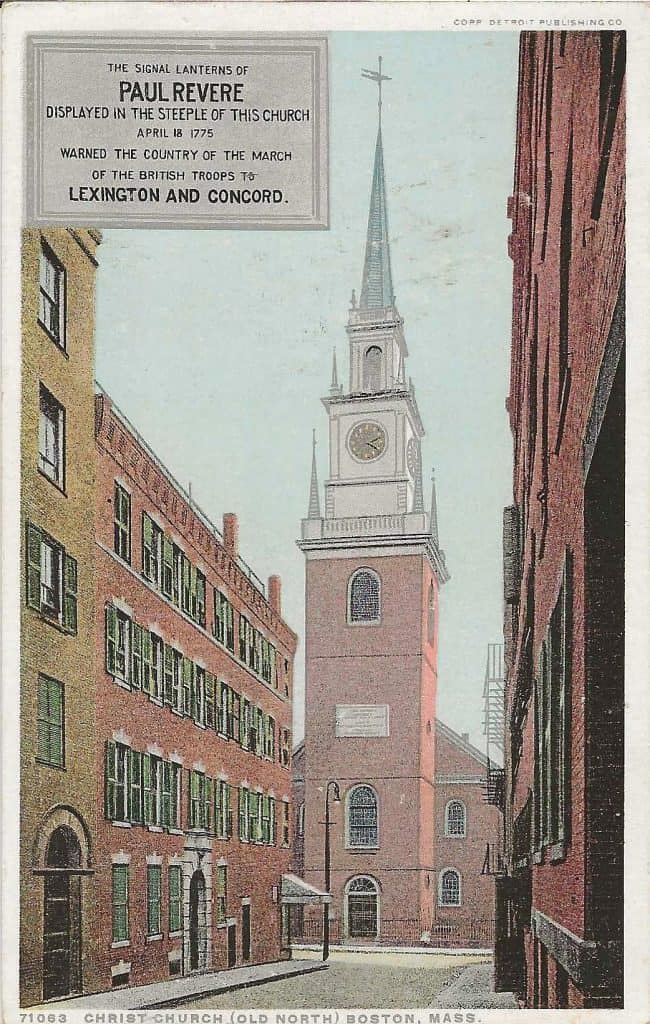
The Old North Church, officially known as Christ Church in the City of Boston, is a historic Anglican church located in the north end of the city. Founded in 1723, it is Boston’s oldest surviving church building. The church is famously associated with Paul Revere’s midnight ride on April 18, 1775, when the church sexton, Robert Newman and vestryman Captain John Pulling climbed the steeple and held two lanterns as a signal from Paul Revere that the British were marching to Lexington and Concord by sea across the Charles River and not by land.
In 1775, on the eve of the Revolution, a substantial number of congregants were loyal to the British King, and many held official positions in the royal government, including the Royal Governor of Massachusetts, making Robert Newman’s loyalty to the patriot cause even more extraordinary.
The church spire reaches 191 feet, making it a prominent feature of the Boston skyline. Today, the Old North Church is a designated National Historic Landmark that welcomes a half-million visitors each year.
Trinity Church on Copley Square
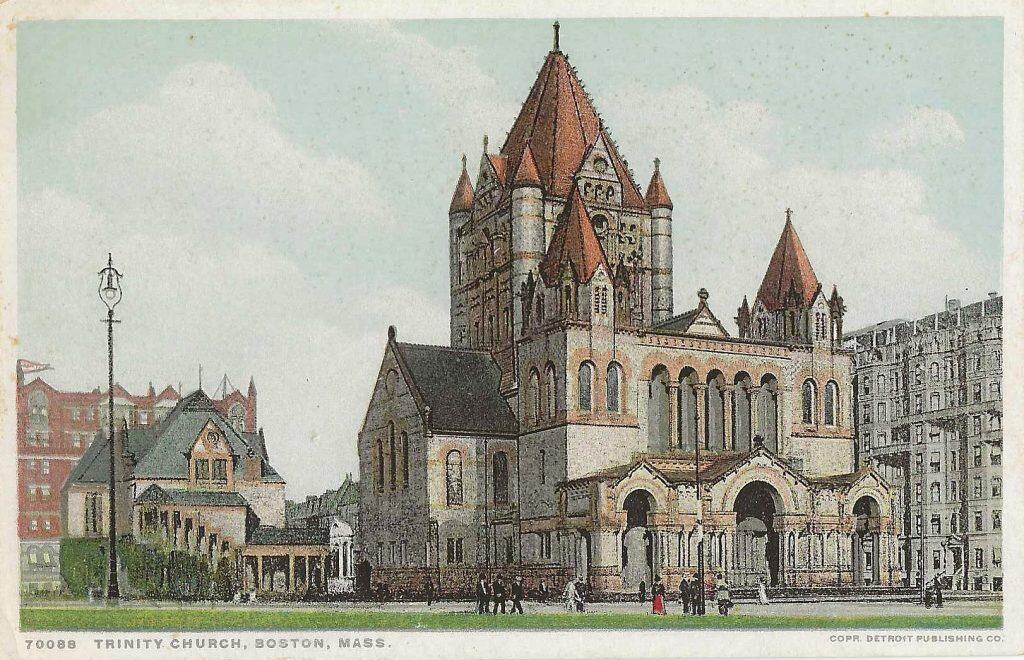
Trinity Church in the City of Boston, like Old North Church is a National Historic Landmark. The building is considered by members of the American Association of Architects as one of Americas most significant structures. The parish that calls it home was founded in 1733, more than 150 years before the current church was built.
The Copley Square building is the third home to this parish. The first two were located in what is now the Downtown Crossing area of Boston. After the second church was destroyed by the Great Fire of 1872, Phillips Brooks, the rector, moved the parish to Boston’s new Back Bay neighborhood, a recently land-filled marsh. Designed by the renowned architect H.H. Richardson, the church was completed in 1877 and is a prime example of Romanesque Revival architecture. Its stunning stained glass windows and intricate interior draw visitors by the thousands.
Phillips Brooks, who was rector from 1869-1891, is still considered the greatest American preacher of the 19th century. [Many of his sermons are still read aloud at special church events.] His Christmas carol, “O Little Town of Bethlehem,” is how most Americans might know him today.
The African Meeting House

The African Meeting House, located on Beacon Hill in Boston, is the oldest surviving African American church in the United States. It was built in 1806.
It served as a vital community hub for free African Americans and abolitionists during a time when racial discrimination was rampant. Constructed by the African Society of Boston, it has hosted significant events, including abolitionist meetings, educational gatherings, and social functions. It was also instrumental in the fight against slavery by introducing notable figures like Frederick Douglass to Bostonians.
Over the years, the Meeting House fell into disrepair but was restored in the 20th century. Today, it is part of the Museum of African American History, serving as an educational resource center.
King’s Chapel
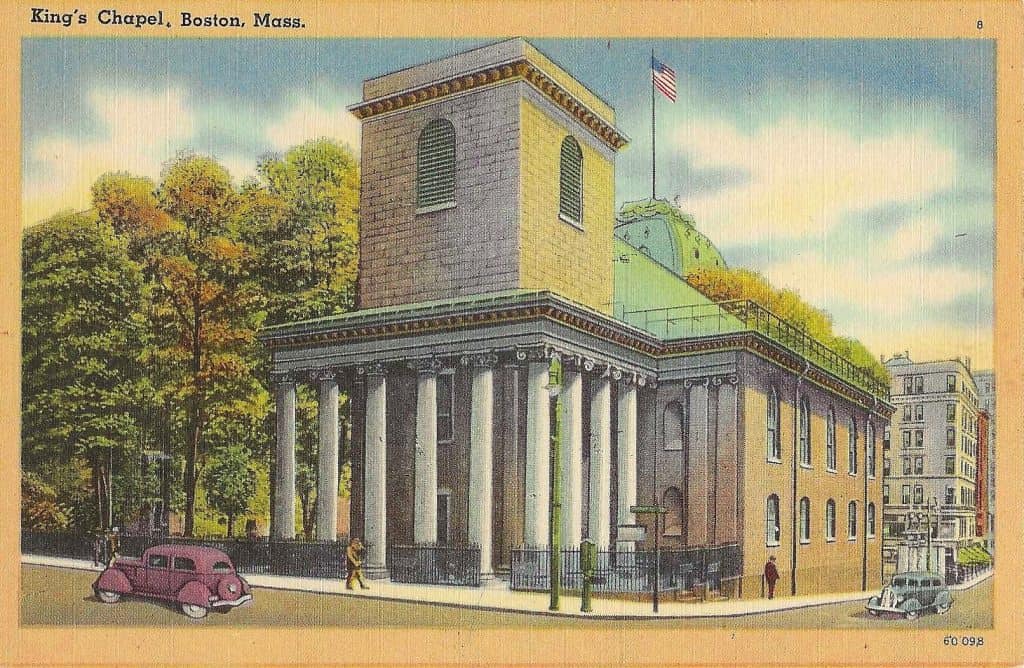
King’s Chapel has roots dating back to 1686. Originally established as an Anglican chapel, it was the first Anglican congregation in New England. At that time, it was also the first state-sanctioned, non-Puritan church in Boston. The city had been predominantly Puritan (religious reformers distancing themselves from the Church of England) since the English started to colonize the area in 1630.
The original wooden structure was replaced in 1754 with the current neo-Georgian stone building, designed by Charles Bulfinch. King’s Chapel has played an important role in Boston’s religious history, including as a meeting place for public discourse.
During the American Revolution, the chapel’s congregation was divided, reflecting the broader political tensions of the time. In the 19th century, theological changes transformed it into a Unitarian church, adopting a more liberal approach to Christianity.
The chapel is also notable for its stunning interior, featuring the unique King’s Chapel organ. It was the first piped organ installed in New England, circa 1713. It is also the church with the oldest pulpit in continual use in the United States, dating back to 1717.
Over the course of its more than three-century history, King’s Chapel has welcomed the wealthy and influential including governors, writers, physicians, and politicians, as well as those who represent the everyday Bostonian.
Park Street Church
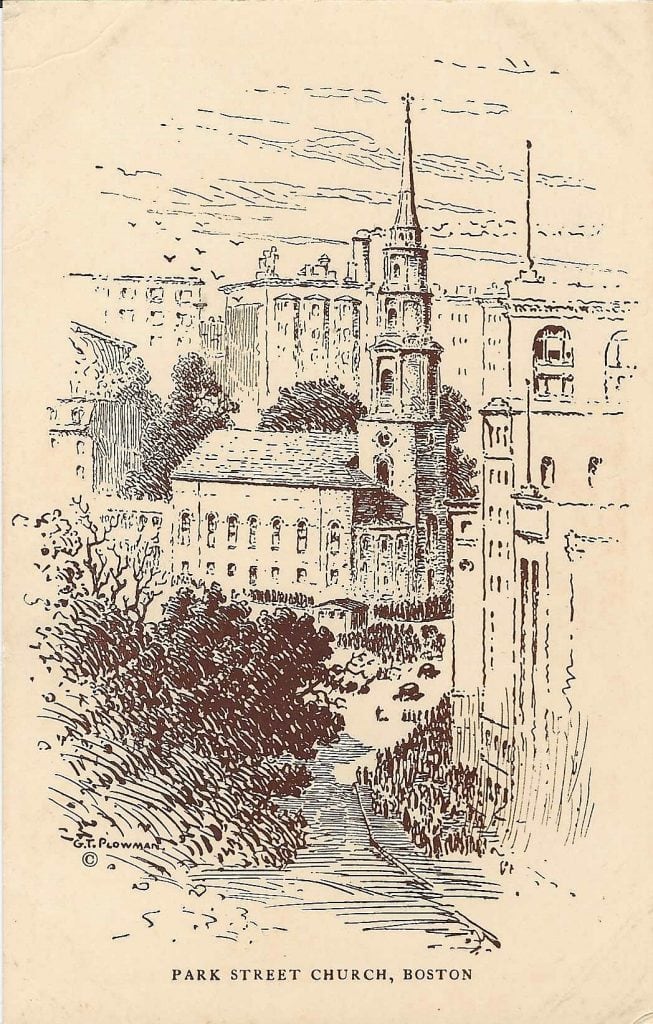
The history of Park Street Church started with its founding in 1809. Established by a group of Congregationalists, the church became a pivotal institution in the city’s religious history. Its striking Federal-style architecture and its iconic steeple, once the tallest structure in Boston, made it a notable landmark on the Boston skyline.
Throughout the 19th century, Park Street Church was the center for various reform movements, including abolitionism and women’s rights. It became known for its involvement in the Underground Railroad, providing sanctuary for escaping slaves. Prominent abolitionists, such as William Lloyd Garrison and Frederick Douglass, were known to participate in the church’s activities.
In the early 20th century, Park Street shifted from Congregational to evangelical influence, hosting speakers like Billy Graham. The church also became known for its commitment to global missions.
Today, Park Street Church continues its mission, serving a multi-generational congregation and engaging in community outreach and global missions, while maintaining its historical significance as a place of worship. Its legacy as a center for faith and social justice remain.
The Cathedral Church of Saint Paul
The Cathedral Church of Saint Paul is the home of the Episcopal Diocese of Massachusetts. Its history goes back to the early 19th century when the ever-growing congregation needed a larger church to accommodate its activities. Construction of the cathedral began in 1877, under the design of architect Henry Hobson Richardson, who was a prominent architect who favored the Romanesque Revival style. The church was consecrated in 1893.
There is an inside joke about the façade of this church. A member of the congregation asked why there were only six columns across the streetside entrance. The questioner was presented with a plain and simple answer, “God doesn’t work on the sabbath.”
The interior is a space with a truly sacred atmosphere. There is a series of beautiful and intricate stained-glass windows, and the hand carved elaborate woodwork is much admired.
In recent years, the cathedral has continued to serve as a worship center by responding to the needs of its modern congregation. The Cathedral Church of Saint Paul remains an historic landmark for all who believe.
***
Data sources vary, but an average suggests there are more churches and chapels in Boston than most major cities. There are at least 33 Christian and Catholic churches, 13 synagogues, 3 major mosques in Boston. There are over 90 religious institutions in the greater Boston metropolitan area. If you can’t find a place to pray, you’re not looking!
***
§ … If you are unaware of how Boston became known as Beantown, it likely originated from the city’s 17th century rum trade, which led to the use of molasses to flavor baked beans. The meal was affordable and quick, and the 17th century Puritans popularized it. The Boston Beaneaters baseball team, which played from 1883 to 1911, also contributed to the nickname’s popularity.
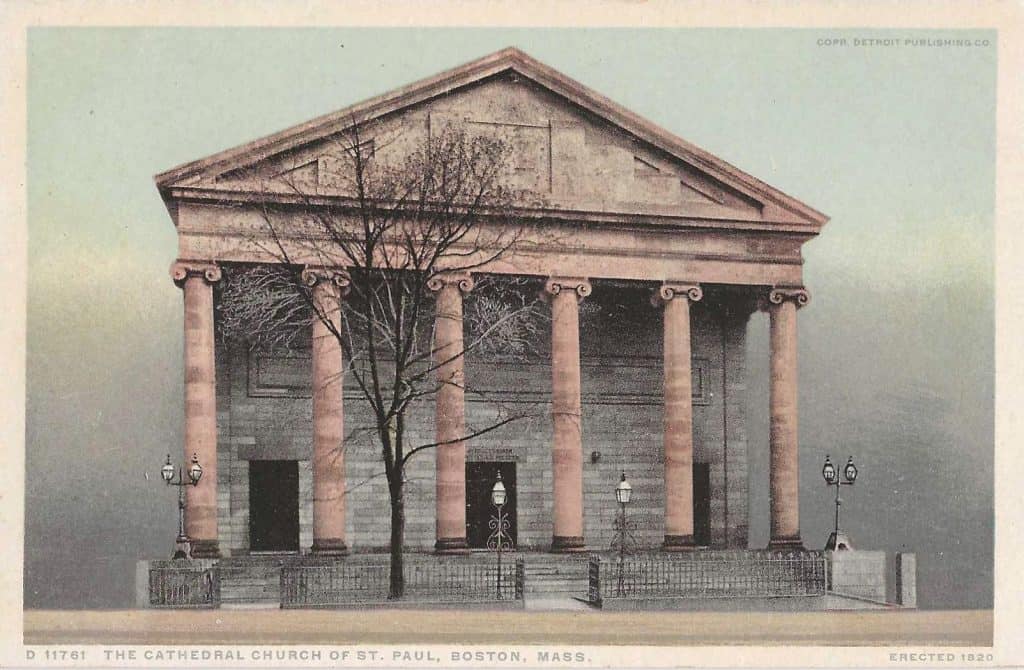
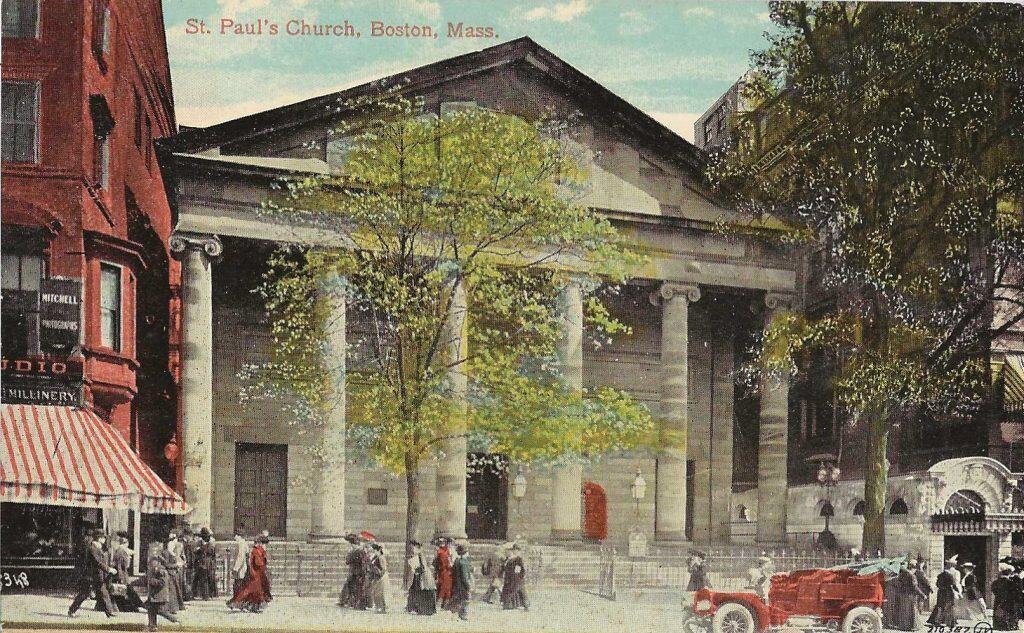
Great article!
Two churches in my hometown, including the church I was married in, were recently destroyed in a tornado. The first thing I did was to pull out my postcards to make sure that I had both of them preserved on postcards and, fortunately, I did.
My mother had to memorize Henry Wadsworth Longfellow’s Paul Revere’s Ride when she was in school, and occasionally recited passages of the poem to my siblings and me when we were growing up.
Yes, Boston certainly does have many churches and a nearly all of them are represented on post cards. I checked my own collection and have 14 different Catholic, 1 Orthodox, 1 Jewish Temple, and 21 of various Protestant denominations (Episcopal, Baptist, Methodist, and others). For many of these, I have several post cards of the same church and some interiors, altars, etc. This count includes only Boston and not its districts (Dorchester, South Boston, Roxbury, etc.), where there are many more! Of course, most of these post cards were produced long ago. Many of these churches have closed or have… Read more »
Great bucket list destinations when visiting Massachusetts.